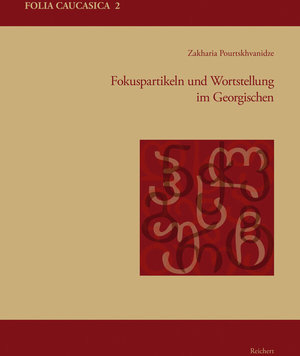
Fokuspartikeln und Wortstellung im Georgischen
von Zakharia Pourtskhvanidze
Die Monographie „Fokuspartikeln und Wortstellung im Georgischen“ stellt eine der ersten korpuslinguistischen Untersuchungen der georgischen Sprache in diesem Umfang dar und basiert auf Materialien aus umfangreichen Datenbanken u.a. dem Georgian National Language Corpus (ca. 130 Mio. Token). Die Erforschung der Informationsgliederung in den menschlichen Sprachen gehört zu den wichtigsten und aktuellsten Aufgaben der modernen Sprachwissenschaft. Im Georgischen sind die meist als „Modalpartikeln“ benannten Elemente, für die in der Monographie die eindeutige Funktion als Fokuspartikeln nachgewiesen wird, allgemein nur wenig erforscht, insbesondere hinsichtlich ihrer funktionalen Distribution.
Als eine Besonderheit der Untersuchung ist der Versuch anzusehen, die Problematik der Fokussierung auf die pragmatisch-funktionale Ebene der Sprache zu übertragen und neben rein syntaktischen auch semantisch-pragmatische Kriterien bei deren Erforschung einzusetzen.
Folgende Punkte sind hervorzuheben:
- In der Literatur unter verschiedenen Namen wie Partikel, selektive Partikel, Morphemoid erfassten Elemente, werden in der Arbeit erstmalig als Fokuspartikeln determiniert und ihnen eine semantisch-funktionale Bedeutung zugewiesen. Gegenüber den in der wissenschaftliche Literatur anhand unterschiedlicher Kriterien determinierten Funktionen und einer allenfalls vorsichtig benannten „Hervorhebungsfunktion“ der genannten Elemente wird in der Arbeit die Informationsgliederung als deren relevante Funktion erkennt und dies funktional eindeutig begründen.
- In der Arbeit wird die Erforschung der Hervorhebungsfunktion (Fokus) auf die gesamte Reichweite der semantischen Modifikationen, die von den Fokuspartikeln ausgehen, d.h. den Fokus-Skopus ausgedehnt. Durch Tests stellt sich fest, dass die Fokuspartikeln ganze Phrasen hervorheben, die dadurch nicht frei umstellbar sind: die Kontrastierung der syntaktischen Stellungstests ermöglicht es, die grammatische und kommunikative Akzeptabilität zu bestimmen und die pragmatische Sensibilität der Fokuspartikeln in ihrem Gebrauch festzustellen.
- Der gleichzeitige Gebrauch von Fokuspartikeln, die zu einer Fokus-Gruppe gehören, ist ausgeschlossen.
- Die Fokus-Gruppen-Bindung und die Stellungsrestriktion der Partikel ist in der Position vor dem Verb stärker als nach dem Verb.
Durch die Stellungsregeln der einzelnen Fokus-Gruppen ist in der Arbeit ein klares, einheitliches Modell der Stellungseinschränkungen in Relation zum Prädikatsverb aufgestellt, das die fokussensitive Verbfinalität als Basiswortstellung im Georgischen determiniert. Die unterschiedlichen Reaktionen der fokussierten Elemente (Wörter/Skopi) in Stellungstests vor und nach dem Verb begründet eine informationsstrukturelle Zweiteilung des Satzgefüges im Georgischen mit der dominierenden Position - FOKUS unmittelbar vor dem Verb.
The monograph “Focus particles and word order in Georgian Language “ represents one of the first corpus linguistic investigations of the Georgian language to this extent and is based on the material of extensive databases amongst other is the Georgian National Language Corpus (around 130 million tokens).
The study of the information structure in the human languages is one of the most important and actual tasks of modern linguistics. In the Georgian language the elements that are mostly known as ”modal particles”, for which the monograph proved its unique function as focus particles, are generally poorly investigated especially with regard to their functional distribution.
As a special property of this investigation, is the attempt to transfer the problematic focussing to the pragmatic functional level of the language and to use in addition to the purely syntactic criteria, the semantic-pragmatic criteria in the study.
The following points are to be highlighted:
- The morphemic reported elements which are found in the literature under different names such as particles, or selective particles are first defined in this study as “focus particles” and they are given a semantic-functional importance. In comparison to deterministic functions in the scientific literature which are based on different criteria and to what is carefully named “highlighting functions” of these elements, the relevant function of the information structure will be detected in this study, and this unique functionality will be justified.
- In this study , the study of the highlighting function (focus) on the whole range of the semantic modifications, which are derived from the focus particles i.e. focus-scopus will be extended. It is to note through tests, that the focus particles highlight total phrases which are not freely convertible. The contrasting of the syntactic order tests enables the determination of the grammatical and communicative acceptance, and the pragmatic sensitivity of the focus particles in their use.
- The concurrent use of the focus particles that belong to a focus-group is excluded.
- The focus-group-bond and the order restriction of the particles is stronger in the position before the verb than in the position after the verb.
- By using order rules of the individual focus-groups in this work, a clear, unified model of the order constraints in relation to the predictive verb is presented, which also determines the focus sensitive verb finalities a base word order in the Georgian language. The different responses of the focused elements (words/scopi) in order tests before and after the verbs establishes an informational and structural division of the sentence structure in the Georgian language , with the dominant position- focus being immediately before the verb.







